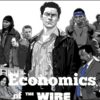027: Craig Medico on How Economics Saved My Career, Using Technology in the Classroom and Why I’m off to Wrestling School
Craig Medico is an Economics and History educator in New York with 11 years of classroom experience. Craig is doing amazing things to get young people to understand and become interested in economics.
classroom experience. Craig is doing amazing things to get young people to understand and become interested in economics.
He is the author of No Bull Review – Macroeconomics and Microeconomics: For use with the AP Macroeconomics and AP Microeconomics Exams (2012) and No Bull Review – Macroeconomics and Microeconomics: Top 10 Guide (2014).
Craig is the developer of several best-selling iPhone test prep apps from Study By App, LLC, including Economics AP (2010), Economics AP Free (2011), and Economics Flashcard Review (2011).
In 2010, he contributed to WNYC Radio/Public Radio International’s morning news program The Takeaway.
Craig is the Macroeconomics instructor for the Junior State of America summer school at Princeton University and teaches Advanced Placement Economics at Paul D. Schreiber High School in Port Washington, New York.
He recently completed an economics educator study tour of Peru with the Global Economic Education Alliance in association with the University of Colorado-Colorado Springs and the Peruvian University of Applied Sciences.
In his spare time, Craig records and produces educational music videos for The Social Studs.
Economic Themes:
In this interview, Craig mentions and discusses: Teaching economics, Advanced Placement program, opportunity costs, supply and demand and the Philips Curve.
Economists:
In this interview, Craig mentions:
John Brock.
Find out:
- about Craig Medico’s education trip to Peru.
- about the class distinction in Peru and how it is upsetting the quality of education for the poor.
- the answer to this problem: 2 + 2 x 2 + 2 Tweet me https://twitter.com/Econ_Rockstar
- how technology can be so beneficial to learning.
- how Peruvian kids are excited about the country’s economic future.
- how a trip to Peru will become part of Craig’s lessons at High School.
- about Craig’s opinions about using technology in education.
- why Craig embraces technology in education both for himself and for his students.
- if there is a disruptive technology that exists that could compromise the traditional bricks-and-mortar way of education.
- what upset Craig when he saw a mother and son at a donut shop.
- how economics saved Craig’s career.
- how idiot-proofing economics allowed Craig to master the concepts.
- about Craig’s philosophy in his teaching methods and how it helps students to learn effectively.
- about the Advanced Placement programs in the United States and how to earn college credit.
- about Craig’s philosophy which is based on the thoughts of Roman Emperor Marcus Aurelius.
- who are George Washing-tone and Abrajamz Lincoln and what are they teaching kids?
- why Craig Medico transforms into Mr Medi-KO and why he’s off to wrestling school.
- about the technological challenges facing all schools today.
- about some of the apps you can use to create educational content.
Defining Moment:
Craig self-proclaimed that he “was actually an economic moron up to about 12 years ago”.
Craig was originally a World History instructor and his school wanted to offer an Advanced Placement program. In order to keep his job, Craig had to “figure out economics. So, in a desperate attempt to keep my job that year, I’d to figure out how to make economics work for me. I’d to figure out a way to idiot-proof the content of the curriculum since I was a complete economic idiot.”
“I was pretty much in my students’ shoes moments before trying to teach them and I used that to my advantage. I knew what it was to be like in their shoes.”
“When you teach something, you reinforce the material for yourself and perhaps take the most important step toward mastery of that content”.
Affirmation/Philosophy:
It’s important to reserve some quite time for myself each day. I try to workout a few days each week even if it’s for 30 minutes. It helps clear the mind. It helps me feel good and if you feel good you look good.
I have this 3 hour window every morning where my mind feels extra sharp and this is where my creative ideas typically originate. Ultimately the goal is just to be a happy person. Be happy with what I do everyday.
“The happiness of your life depends on the quality of your thoughts” – Roman Emperor Marcus Aurelius.
Influencers:
My students influenced Craig the most when it came to writing the books and apps.
“When it comes to developing material for the classroom, my influencers are Metallica, KISS, Aerosmith and the Rolling Stones. I used to view each lesson as a performance – like a rock show.”
Takeaway:
No matter how old you are or where you are in life, always be an active learner. There’s nothing more rewarding than learning new ideas, new activities, taking on new hobbies. And then once you learn something, become a teacher. Share it with the people around you.
About the Use of Technology in Education:
I love it. I don’t think it necessarily replaces the classroom experience. But it supplements it in such a great way. I view the online stuff as just another way of diversifying how we learn.
MOOCs are the big thing in education right now. To take a class with 80,000 other students – how cool is that? And do it on your own terms, do it at low or no cost.
“I got into technology because it’s fun. It’s so much fun to put the websites together and the apps, the books and the videos on YouTube. I do it to keep things interesting for me. If I taught the classes the same way every single year I would end up in a huge rut. My goal is to constantly improve and be as great as a teacher as I can for my students.”
“I think human interaction is very important. Especially in the workplace where we still have to deal with human beings. We’ve gotta create students who can handle that down the line.”
Tools Educators Can Use to Help with Teaching:
- Powerpoint: Allows diagrams to show movement such as changes to curves.
- Snapchat
- Apps:
- Explain Everything – Used to make YouTube videos.
- AppShed – create your own apps or get students to create their own.
- Socrative – Socrative lets teachers engage and assess their students with educational activities on tablets, laptops and smartphones.
- studybyapp – provides an intuitive web-based platform that enables you to build apps that fit your needs.
Education in Peru: A Tale of Two Standards but a Key Determinant to Long-Term Economic Growth
A recent trip by Craig Medico and 11 other educators from the USA was organised by the Global Economic Education Alliance in partnership with Dr. John Brock, Director of the Center for Economic Education at the University of Colorado, Colorado Springs (UCCS) and Claudia Sicoli, Director of the Centro de Educación Económica de la Universidad Peruana de Ciencias Aplicadas (UPC) in Lima, Peru.
Mr. Medico embarked on a tour of Peru’s educational system as well as experiencing some of the economic development that has been going on in Peru over the last few decades. This trip was a great opportunity both for Peru and the USA to forge an education alliance and to open up a teacher-exchange in the future and to improve the education system in both places.
Craig visited wealthy private schools, middle-class private schools and poor public schools, as well as meeting with students at the local university. He, along with the other educators met with representatives of the Central Bank of Peru and the ministry of education.
Craig found a lot of challenges and inequities throughout Peru’s educational system. A visit to one upper-class private school in Lima was an ‘eye-popping experience’. This was a trophy school that epitomised the trappings of wealth and symbolized the success of Peru’s economy. “It resembled more of a country club than a school – large outdoor swimming pools, soccer fields, lots of open space. Lots of technology in the classroom, every student had their own computer”.
The construction of new buildings on the grounds of this private school confirmed its continued and rapid expansion and is analogous to the determination of Peru to be the best in attaining educational standards. Students are granted a lot of academic freedom through project-based learning. “Most of the instructors are foreign that would come in from overseas and teach for a couple of years. They seem to be high-level teachers.”
It was a totally different story for a poor public school outside Lima. “That school was surrounded by dirt and dilapidated housing. I didn’t see a single computer in a classroom. The closest thing was a dusty broken TV set that didn’t work anymore. The students seemed very unengaged and many were confused. I observed one teacher who was teaching students completely incorrect information.”
In that particular lesson, students were working in groups to understand bar graphs. Their prop were wooden boards with nails sticking out from them and they were creating bar graphs with rubber bands. Craig is shocked at how this school has fallen behind in standards, particularly failing to embrace technology due to the lack of funding it receives.
“Many struggle through it and I’m thinking, WOW, this is a great example of where technology, like an interactive white-board, would greatly enhance these kids’ classroom experience.”
The thing that struck Craig the most, in addition to the technology, was the teacher’s approach to teaching math. She wasn’t teaching math using the ‘Order of Operations’ – the PEMDAS Rules that are applied to learning in 3rd and 4th Grade. She was just solving problems on the board left to right. Craig was so concerned about a math problem that was being solved incorrectly by the teacher at this point that he imagined mistakes and incorrect information being taught at other schools, not only in Peru, but also in the US.
Craig interacted with kids from a Middle School in Cusco, Peru who where so excited about their country’s economy and what it means for them. When they asked Craig and the other educators about their personal thoughts, Craig, in true economic fashion, highlighted the key underlying strengths and benefits that are determining factors to a successful economy: the valuable inputs and factors of production, property rights are better protected, buildings and infrastructure is being built to accommodate growth and sustain future economic development.
However, Craig gravitated toward education being the number one catalyst for maintaining a healthy, vibrant and opportunistic economy, which is a reflection of his true-calling as a passionate and dedicated educator. “Improving education and human capital is going to be the main determinant as to whether Peru is going to be a true economic powerhouse over the longer term.”
Craig is an champion and a hero, not just in the wrestling ring, but in the classroom. His passion and dedication exudes and shines through his continued and dynamic approach to making learning (and teaching) fun and accessible. Craig is an early adopter of the use of technology and social media in the classroom, which embraces the needs of both student and teacher. His students are extremely lucky to have a teacher so dedicated to giving it all and I sincerely hope they realise this. It seems that he has unlocked the true meaning of life: help others and find happiness in the things you do each day.
Recommended Books:
- No Bull Review – Macroeconomics and Microeconomics: For use with the AP Macroeconomics and AP Microeconomics Exams (2012) by Craig Medico.
- No Bull Review – Macroeconomics and Microeconomics: Top 10 Guide (2014) by Craig Medico.
- The Stoic Philosophy of Seneca: Essays and Letters by Lucius Annaeus Seneca
Apps by Craig Medico:
- Economics AP Free
- Economics AP
- Economics Flashcards
All three apps by Mr Medico can be found on the iTunes store but here is a link that will take you to his website showing the apps on the right of the homepage.
Where To Find Craig Medico:
- Website: www.mrmedico.info
- Twitter: @mrmedicoinfo
- email: cmedico@gmail.com
- YouTube: SocialStudsRock
Podcast: Play in new window | Download
 060: Manu Saadia on Trekonomics – The Economics of Star Trek: Scarcity, Productivity and Public Goods
060: Manu Saadia on Trekonomics – The Economics of Star Trek: Scarcity, Productivity and Public Goods 110: Beatrice Cherrier on the Economics of ‘The Wire’ and the Beginning of Economics at MIT
110: Beatrice Cherrier on the Economics of ‘The Wire’ and the Beginning of Economics at MIT 011: Steve Keen on Debunking Economics and the Misinterpretation of Keynes
011: Steve Keen on Debunking Economics and the Misinterpretation of Keynes 126: Jeffrey Miron on Libertarianism, Drug Legalization and Genghis Khan
126: Jeffrey Miron on Libertarianism, Drug Legalization and Genghis Khan 155: Lotta Moberg on Refugee Cities and the Blockchain Industry as Special Economic Zones
155: Lotta Moberg on Refugee Cities and the Blockchain Industry as Special Economic Zones 093: Arthur Charpentier on Freakonometrics, Machine Learning and Big Data
093: Arthur Charpentier on Freakonometrics, Machine Learning and Big Data 141: Dan Hamermesh on the Economics of Sleep
141: Dan Hamermesh on the Economics of Sleep 071: Darshak Patel on Using Popular Culture to Engage Economics Students in the Classroom and Online
071: Darshak Patel on Using Popular Culture to Engage Economics Students in the Classroom and Online 023: Loretta Napoleoni on Financing Terrorism and the Creation of the Islamic State
023: Loretta Napoleoni on Financing Terrorism and the Creation of the Islamic State 038: Leah Bell on Being an Angry Grad and Setting Yourself Up for a Life of Success
038: Leah Bell on Being an Angry Grad and Setting Yourself Up for a Life of Success